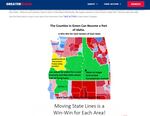
A screengrab from the Greater Idaho website.
Screengrab
Idaho lawmakers appeared intrigued but skeptical on Monday when pitched a plan to lop off about three-fourths of Oregon and add it to Idaho to create what would become the nation’s third-largest state geographically.
Representatives of a group called Move Oregon’s Border For a Greater Idaho outlined their plan to a joint meeting of Idaho lawmakers from the House and Senate on Monday.
The Idaho Legislature would have to approve the plan that would expand Idaho’s southwestern border to the Pacific Ocean. The Oregon Legislature and the U.S. Congress would also have to sign off.
Supporters of the idea said rural Oregon voters are dominated by liberal urban areas such as Portland, and would rather join conservative Idaho. Portland would remain with Oregon.
“There’s a longtime cultural divide as big as the Grand Canyon between northwest Oregon and rural Oregon, and it’s getting larger,” Mike McCarter, president of Move Oregon’s Border for a Greater Idaho, told Idaho lawmakers.
If everything falls in line with Oregon, supporters envision also adding adjacent portions of southeastern Washington and northern California to Idaho. Backers said residents in those areas also yearn for less government oversight and long to become part of a red state insulated from the liberal influence of large urban centers that tend to vote Democratic.
“Values of faith, family, independence. That’s what we’re about,” said Mark Simmons, an eastern Oregon rancher and former speaker of the Oregon House of Representatives. “We don’t need the state breathing down our necks all the time, micromanaging our lives and trying to push us into a foreign way of living.”
President Joe Biden easily won Washington, Oregon and California in November, while President Donald Trump carried Idaho with 64%. The Idaho House and Senate each have supermajorities of Republicans.
The group's strategy has been to get advisory votes in Oregon counties likely to make the switch. But last November the group had mixed success with two counties opting to join Idaho but two wanting to stay a part of Oregon. Supporters blamed the setback on the coronavirus pandemic and an inability to get their message out. Five more Oregon counties are expected to vote on the matter in May.
The county votes carry no weight, but are intended to potentially sway lawmakers to ultimately approve the plan.
Republican Rep. Ben Adams, one of Idaho's more conservative lawmakers who gave a fiery speech on the House floor last week revolving around freedom, said his interest was piqued but wondered why Oregon lawmakers would agree to the plan.
“How is it being received right now by the state of Oregon?” he asked. "How hard would they be fighting to make it not happen? Most states don’t like to lose their resources to their neighbors.”
McCarter said he's had no contact with the state government but expects supporters will make themselves known eventually.
“I believe that there are a lot of people standing on the sidelines watching this particular issue," McCarter said. "Is there any traction to it? Is there anything behind it?”
He said the votes coming up in the five counties in May could be an indicator.
Democratic Sen. Michelle Stennett, who represents one of the few liberal-leaning areas of Idaho that include the resort towns of Ketchum and Sun Valley, wondered how people in Oregon making a minimum wage of $11.25 would like a pay cut to Idaho's minimum wage of $7.25.
There were also questions about paying for roads, schools, prisons and state employee retirement obligations. Idaho also prohibits any marijuana use, including medical. In Oregon, recreational pot is legal.
Simmons and McCarter agreed there were many problems that needed to be worked out before Idaho could absorb rural areas of surrounding states.
“There are a lot of details, a lot of details,” Simmons said. “And before we can even begin to discuss the details, we have got to see a significant majority of counties in Oregon stepping up to support it.”